New breed of all-electric camper vans promises zero-emission adventures
Embrace the fast-expanding world of electric camper vans and RVs – from full conversions to tantalising future concepts – for silent running and zero emissions
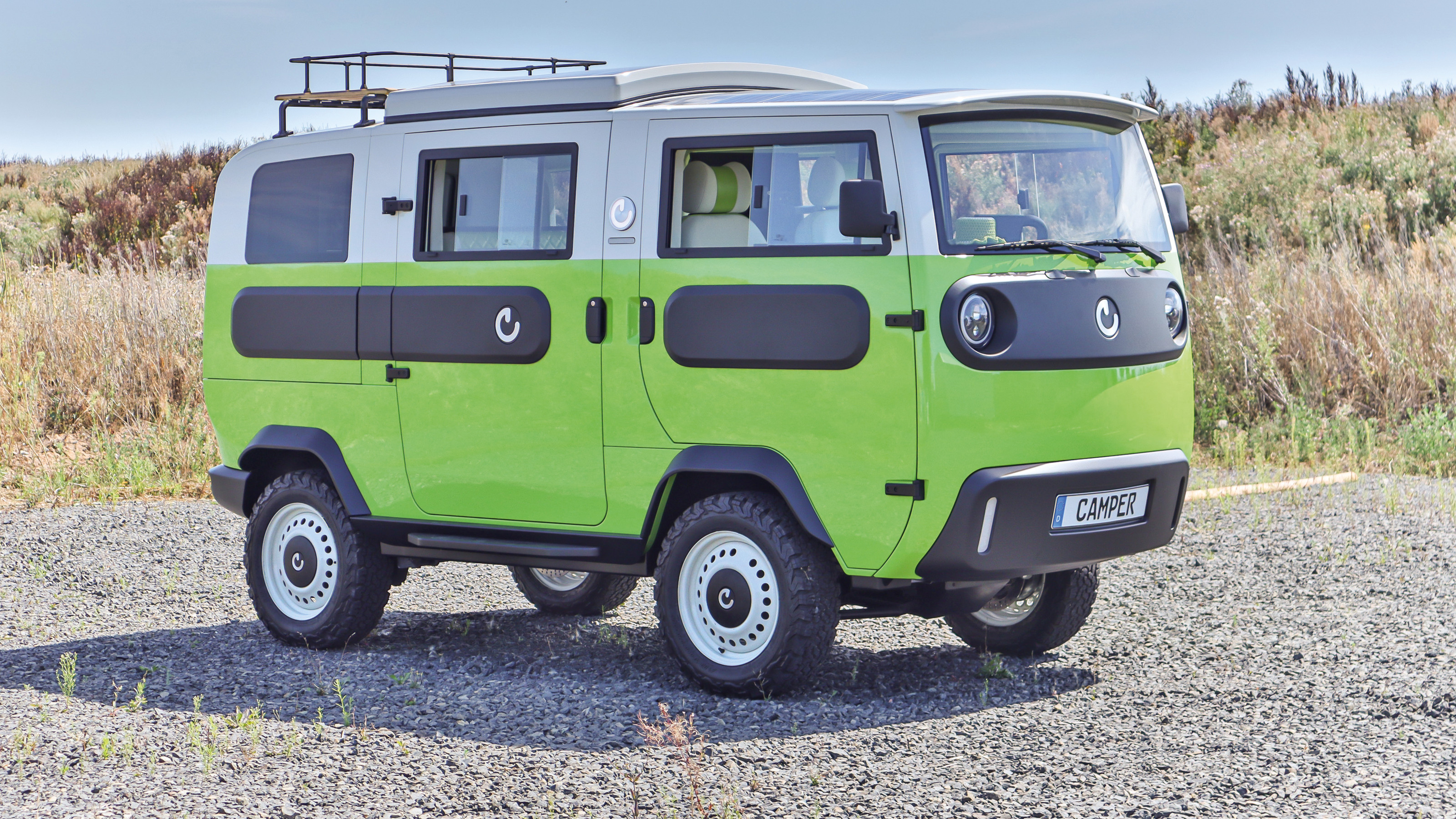
It stands to reason that the next big revolution in the RV world is electrification. Yet unlike their commercial and consumer equivalents, camper vans and recreational vehicles have very different demands on power, range and space. What might suit a short-range city delivery service won’t necessarily suit a long-range, off-grid camping vehicle, where survivability is key, and the reliability of a gas-powered generator will always trump a solar array.
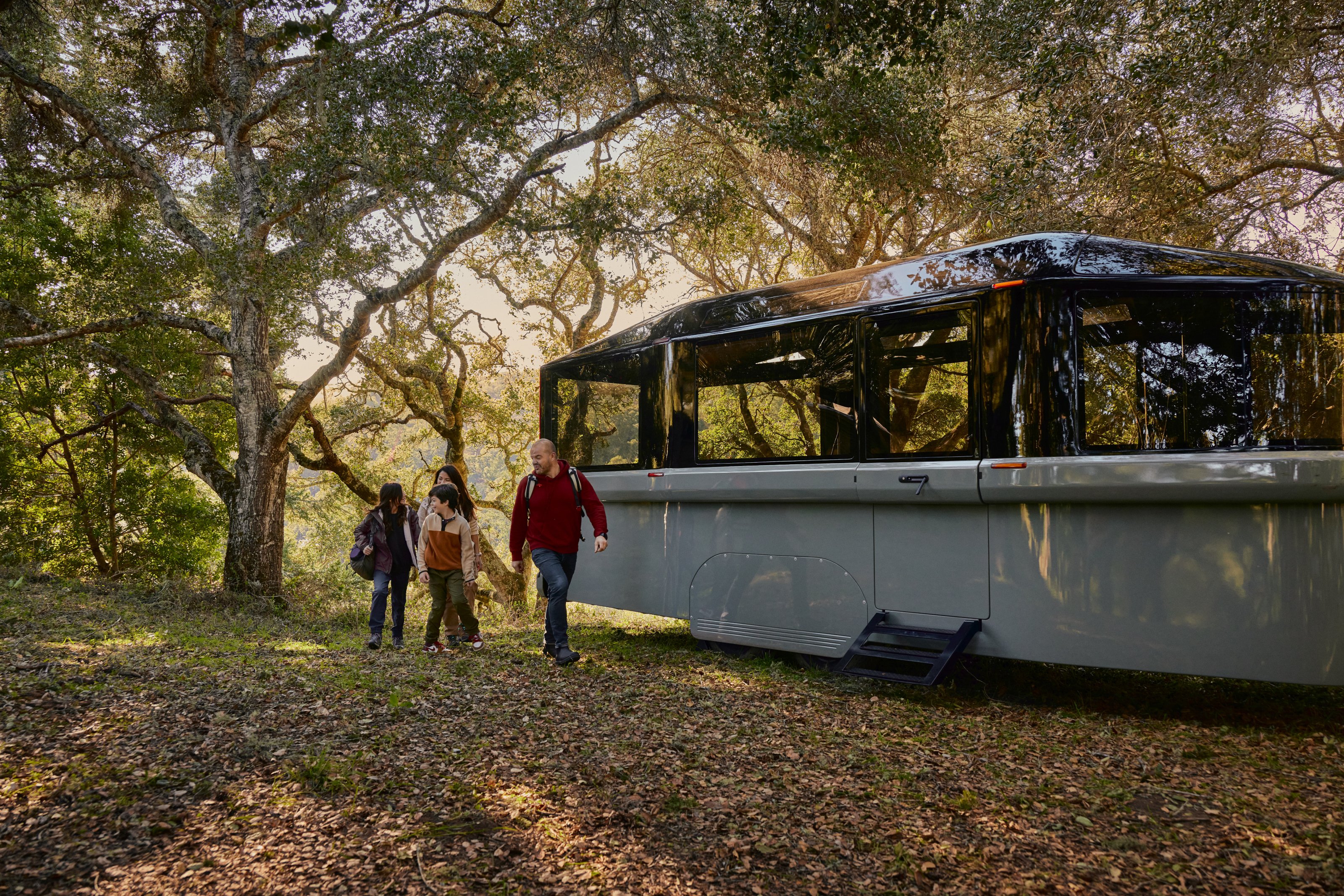
The Lightship L1 is a travel trailer designed to be pulled by an EV
Volkswagen has finally launched its long-awaited ID.Buzz Stateside, while EV-only travel trailers like the striking Lightship L1 demonstrate that aesthetics are changing just as fast as the tech underneath. Traditional campers are still being subverted, but at this stage in the electrification of camping we’re still very much in the realm of conversions, as the following list confirms.
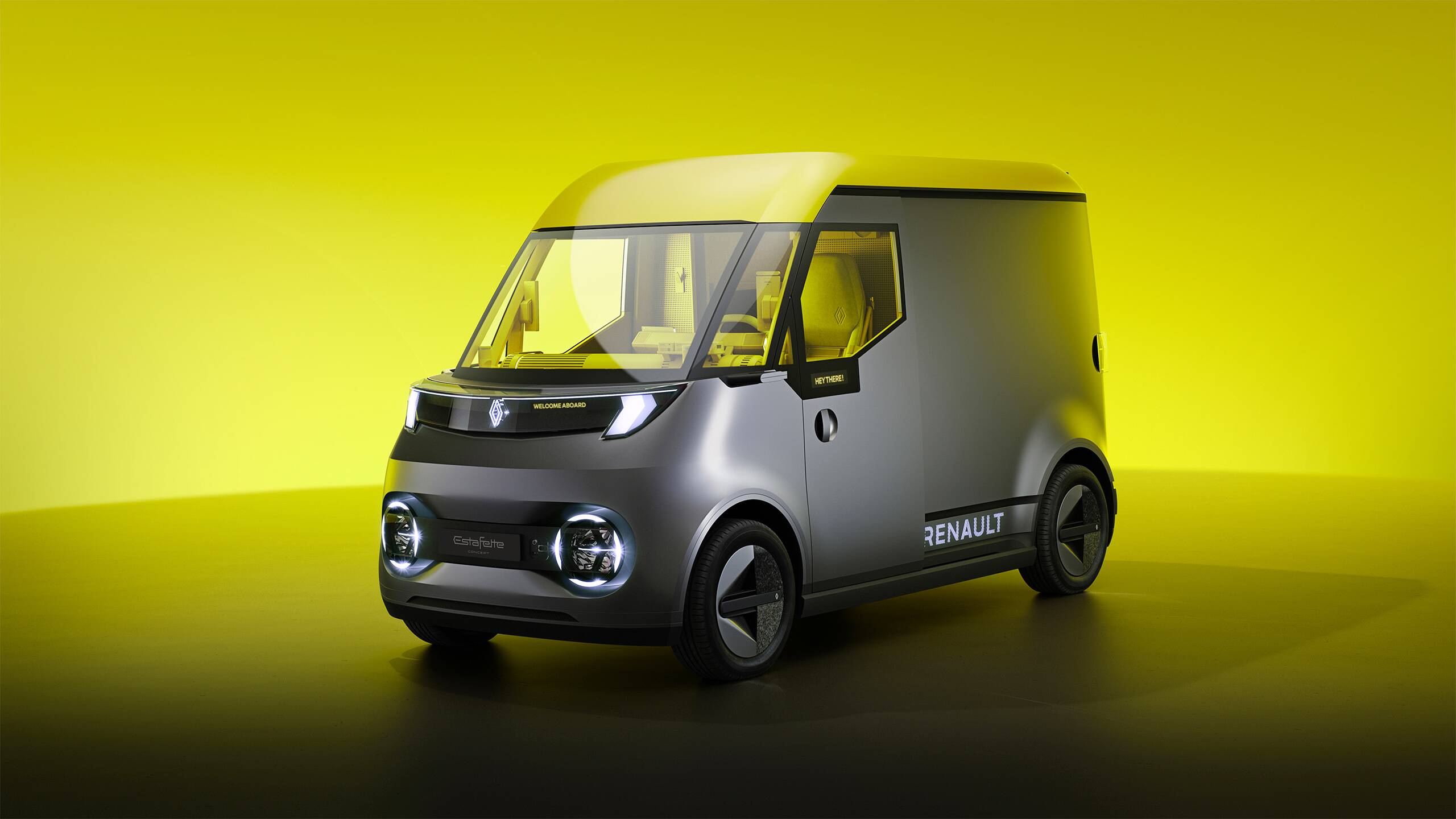
A future camper platform? Renault's Estafette Electric Van Concept
However, purpose-built electric vans are becoming far more commonplace, aimed first at the world of work. Renault’s amazing Estafette Electric Van Concept debuted at this year’s Paris Motor Show, while Canoo’s MPDV delivery vehicle also shows promise. Sharp recently showed off its Sharp LDK+, an EV the company described as an ‘extended living room’, and there are also rumours of a 'Rivian Adventure Van' coming in 2025, something that splices the ruggedness of Rivian’s off-roaders with the spacious interior of the Rivian Commercial Van.

Clearly, the future will offer way more options for keen converters. In the meantime, here’s our updated selection of what to look out for in the world of zero-emission van living.
eVentje by Ventje

The ID Buzz-based eVentje by Ventje
The first of several new VW ID Buzz conversions, the eVentje is Dutch specialists Ventje's entry into the zero emission camper game. With an electric cooker, plenty of sockets, an onboard solar panel and a pop-top roof, as well as a plethora of power sockets and LED lighting throughout, the eVentje is a thoroughly modern take on the camper van aesthetic VW introduced to the world with the 50s-era Type 2 VW Transporter.
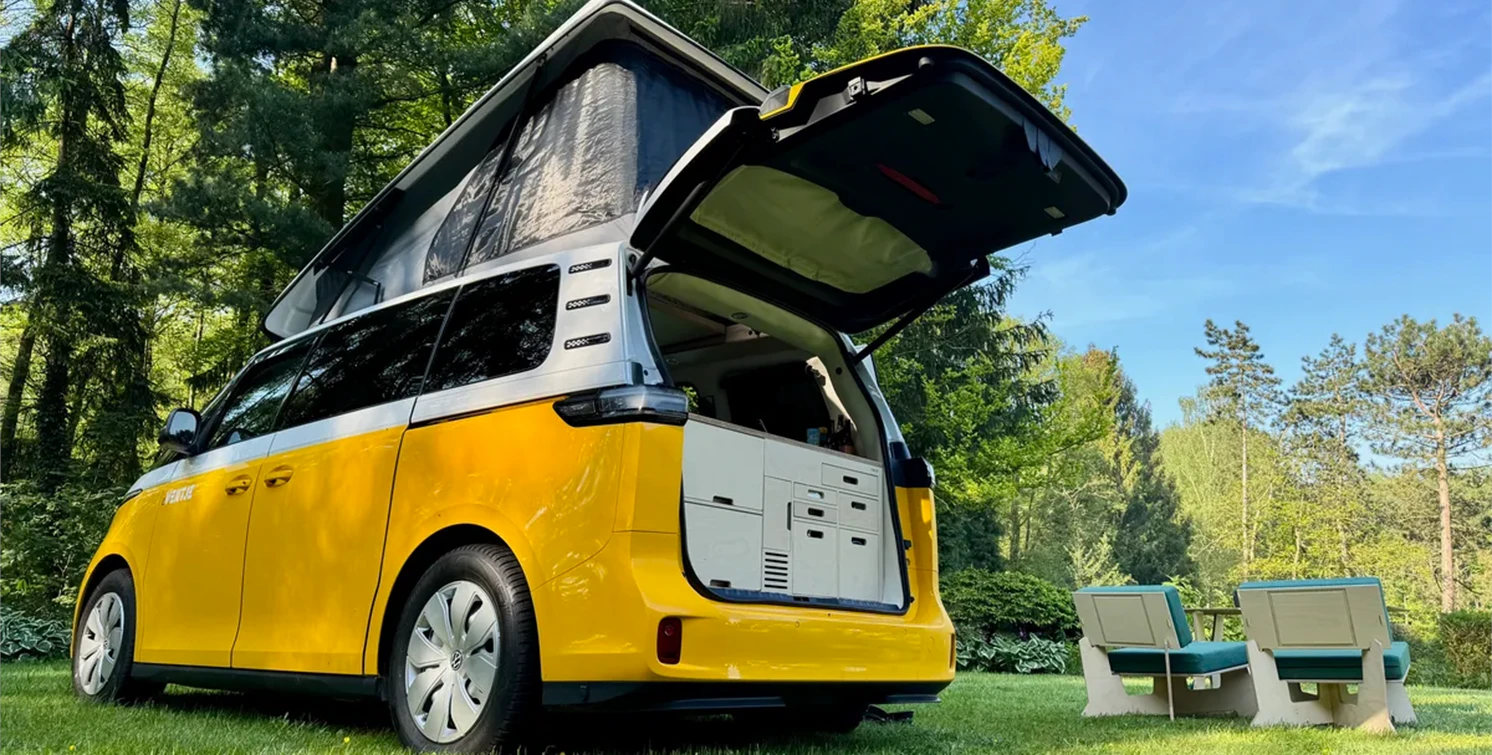
The eVentje comes with a pop-top and a slide-out kitchen
eVentje by Ventje, from €95,000, Ventje.com, @Ventje_camper
Vanacea by Maxwell Vehicles

Vanacea by Maxwell Vehicles
LA-based specialists Maxwell Vehicles can supply a fully electric van with an interior fitted out by specialist builders Rossmonster. One big draw is the full solar roof that the company claims to provide up to 1,500 Watts of charging when you park in full sun. This adds up to a ‘daily range bonus’ of 20 miles on especially fine days, or around 8.5 kWh of battery charge. The floor mounted battery pack frees up more of the interior for Rossmonster’s custom cabinetry, galley and storage.
Receive our daily digest of inspiration, escapism and design stories from around the world direct to your inbox.
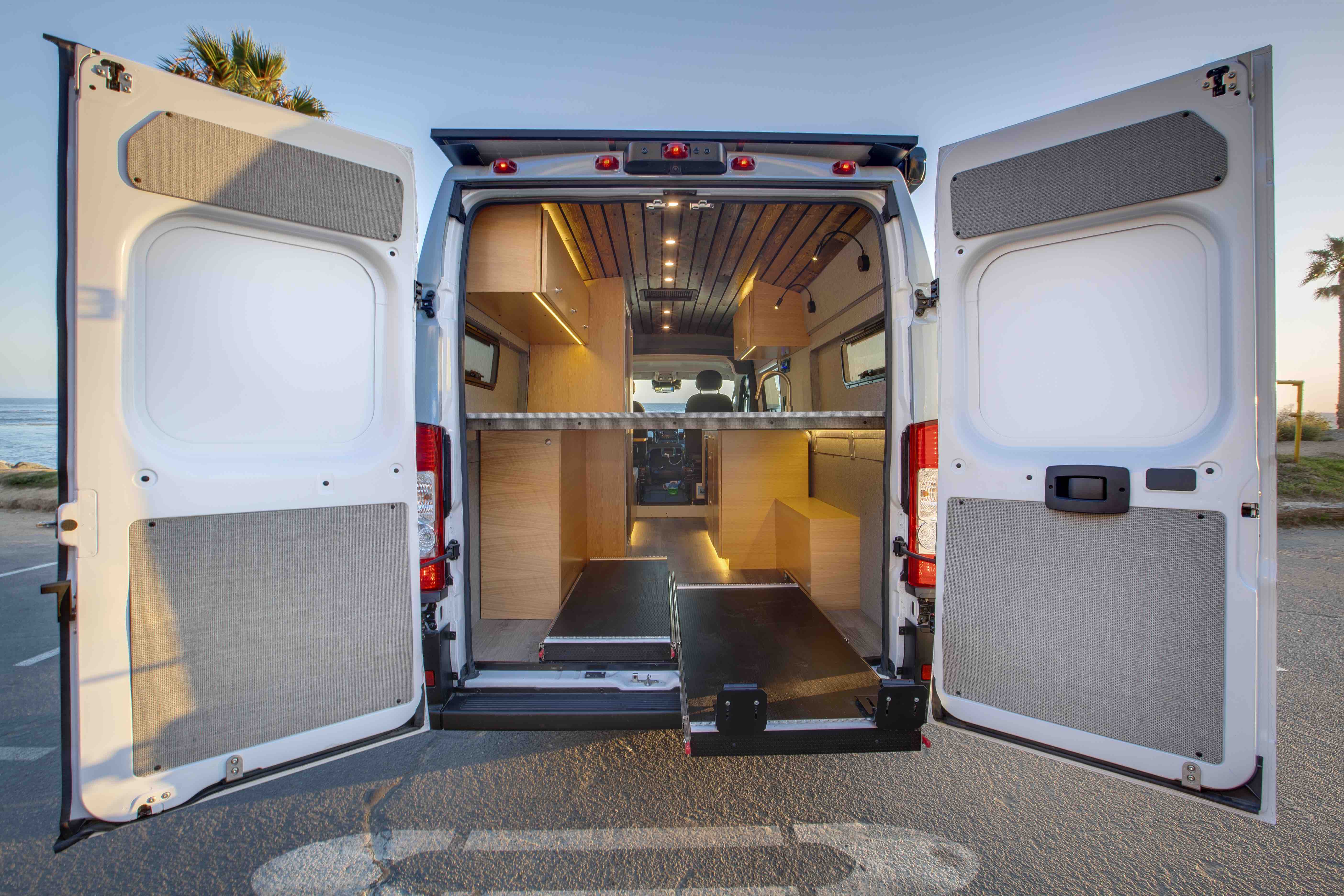
Vanacea by Maxwell Vehicles feature custom interiors by Rossmonster
Vanacea, price on application, MaxwellVehicles.com, Rossmonster.com
THOR Vision Vehicle
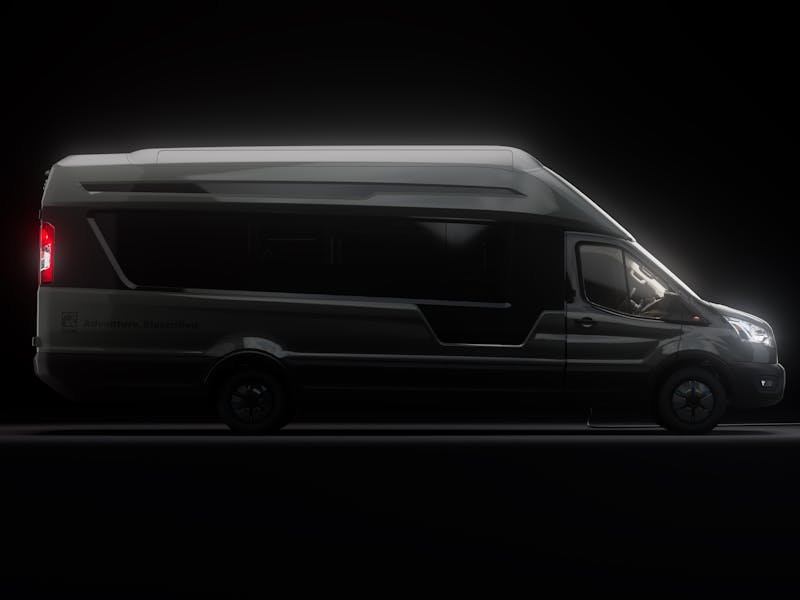
THOR Vision Vehicle
The Vision Vehicle is American RV stalwart THOR’s vision of the near future, offering a 300 mile range from a large battery pack and fuel cell combo, with a tech-filled interior to create a ‘home away from home’.

Inside the THOR Vision Vehicle
The company also recently collaborated with Harbinger to create a new Class A motorhome platform (the largest camper platform), an electric powered RV concept that combines a 140 kWh battery with a gasoline-powered range extender to give a range of 500 miles.
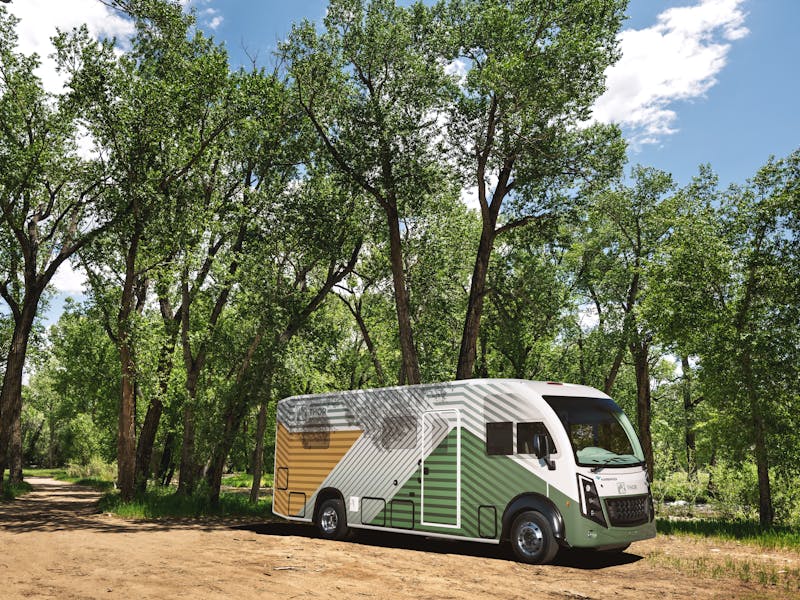
Thor Hybrid concept
THOR Vision Concept, THORIndustries.com, HarbingerMotors.com
ElectricBrands XBUS Camper
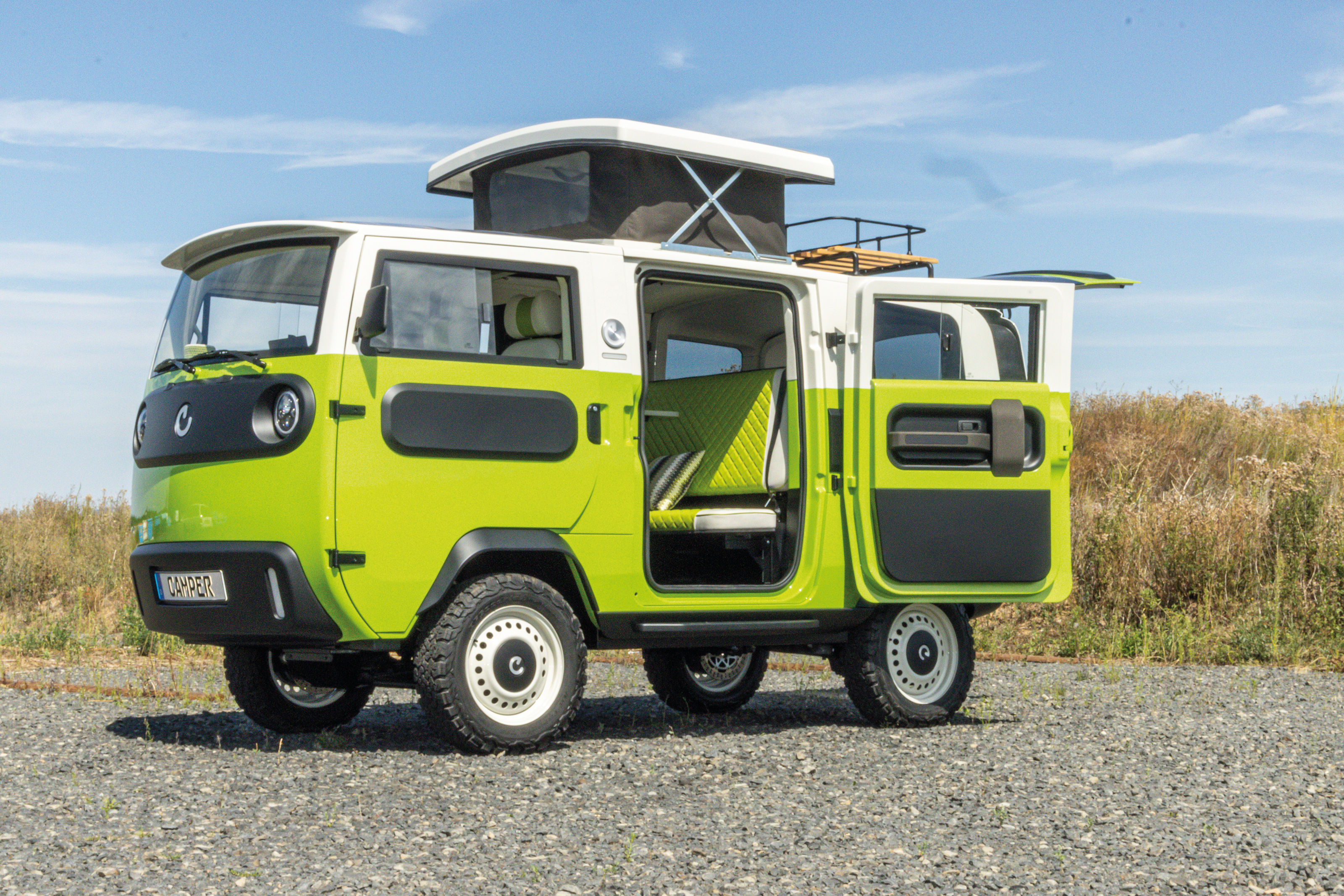
XBUS Camper by ElectricBrands
The diminutive XBUS is a multipurpose platform designed by German company ElectricBrands. It’s available as a regular van, pick-up, catering truck, passenger vehicle and camper, and the company is currently taking orders.
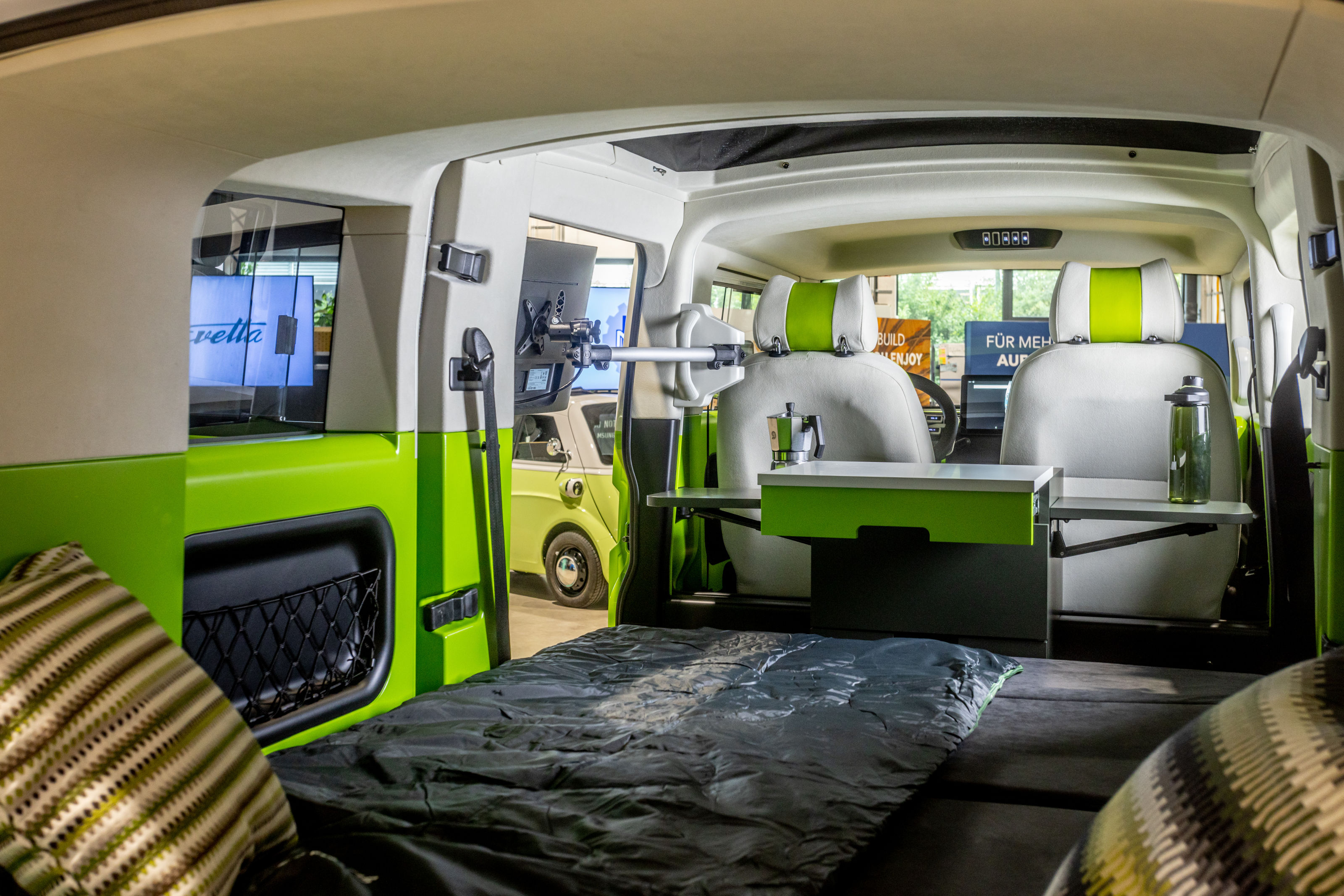
Interior of the XBUS Camper by ElectricBrands
The camper variant is available in both standard and off-road configurations, with sleeping space for two formed from two add-on camper modules, both of which feature extendable living space. The standard battery promises a 200km range, although extended capacity is also available.
XBUS Camper, from €29,727.73, ElectricBrands.de
Tonke ID.Buzz
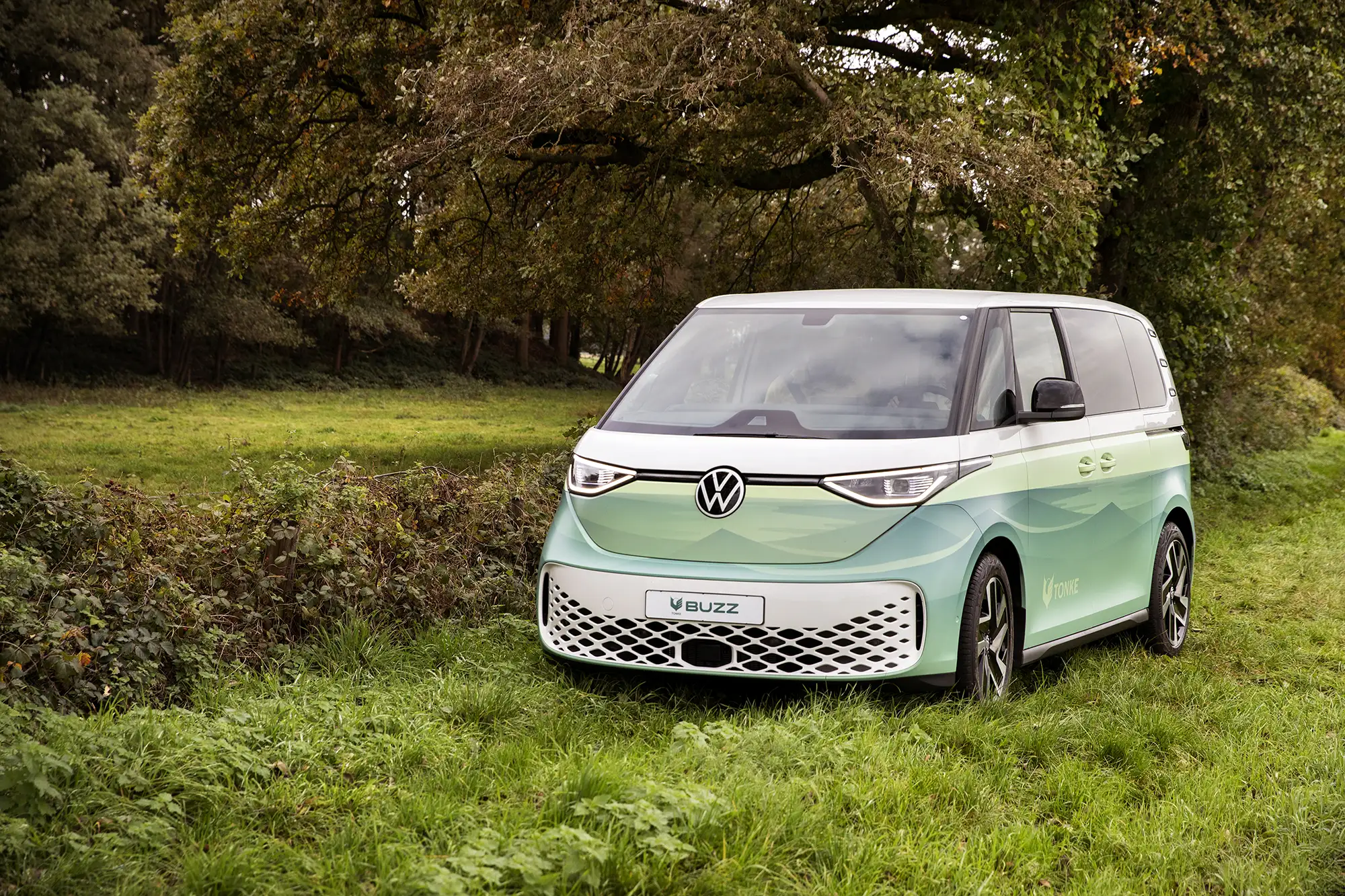
This is the Tonke ID.Buzz, the Dutch company's companion to its EQV model. Many EV-minded campers are holding out for an official electric camper version of the acclaimed ID.Buzz, but it still looks like it'll release a hybrid camper version of its Volkswagen California camper first and foremost.
Tonke ID.Buzz, Tonke.eu, @Tonke_Vans
Alpincamper ID.Buzz
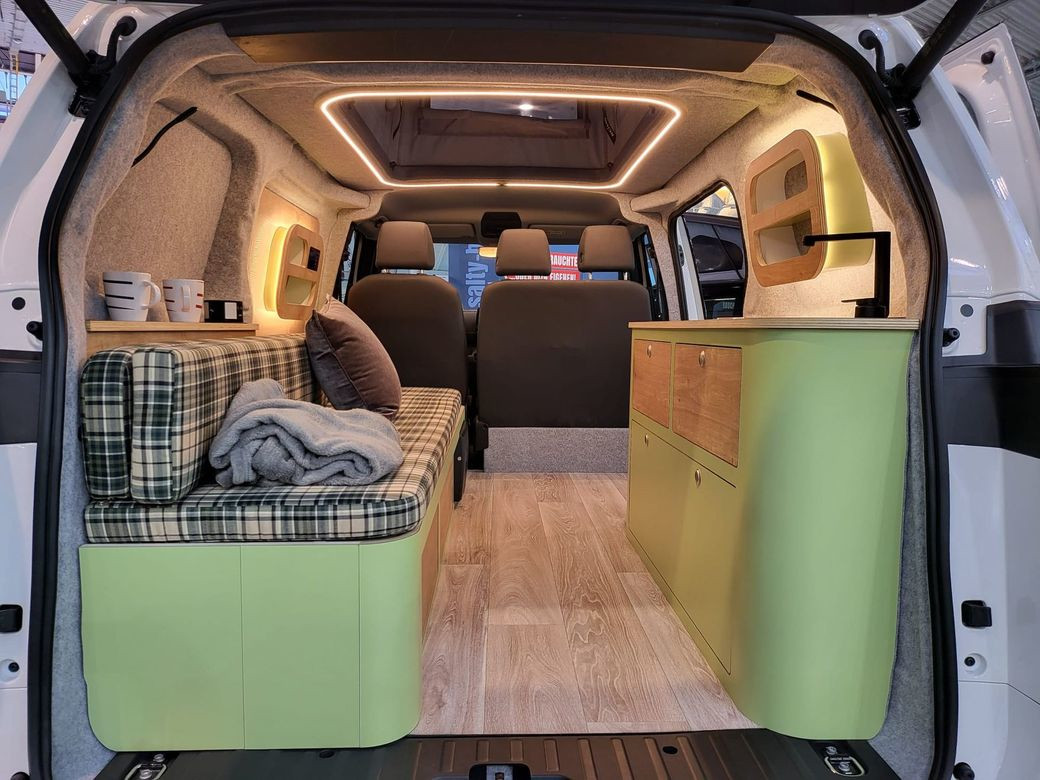
Interior of ID.Buzz Camper by Alpincamper
German van conversion specialist Alpincamper claimed to have made the very first conversion of the Buzz, with this sleekly designed two-berth model that makes the most of the interior space with an aesthetic that mirrors the Buzz’s chunky, soft-edged interior scheme. The company says the conversion doesn’t dent the Buzz’s maximum range of around 248 miles.
Alpincamper ID.Buzz, more details at Alpincamper.de
Grounded RVs

The modular interior of the Grounded G1
Detroit-based start-up Grounded has pivoted from using the Ford E-Transit platform to using the GM BrightDrop as the basis for its Zevo 600 or Zevo 400 electric RVS. Still aimed at the American market, the company places an emphasis on space and function, with a modular interior system that can be upgraded over the lifecycle of the van.
Grounded G1, price tbc, GroundedRVs.com
Winnebago eRV2 concept
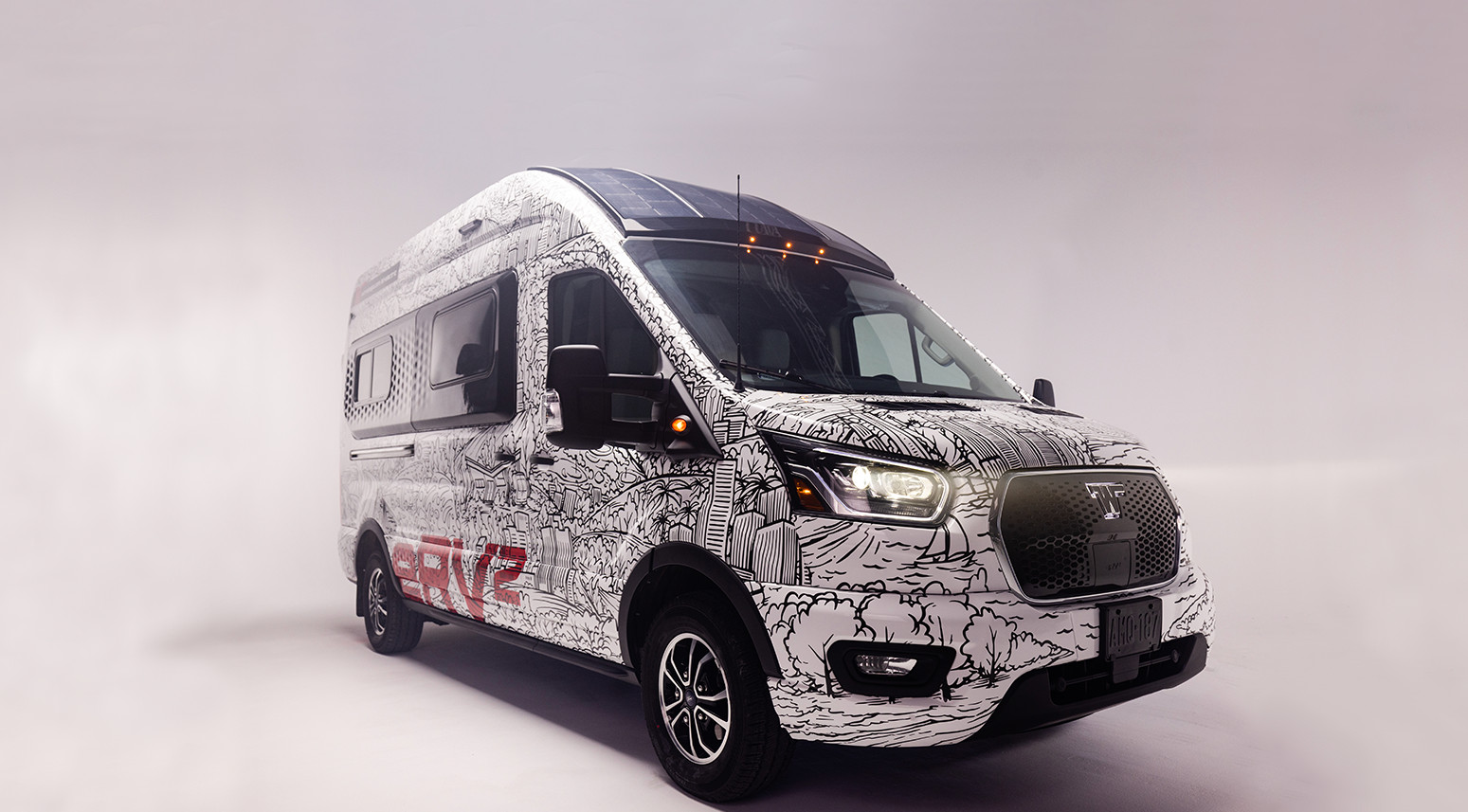
Winnebago eRV2 Concept
As the name suggests, this is all-American brand Winnebago’s second electric camper concept, based on the Ford E-Transit (the company says it is ‘actively pursuing’ range extension opportunities to incorporate into a future commercial version). In addition to the electric powertrain, the eRV2 is a showcase for sustainable and recycled materials, as well as a layout tailored to working on the road.
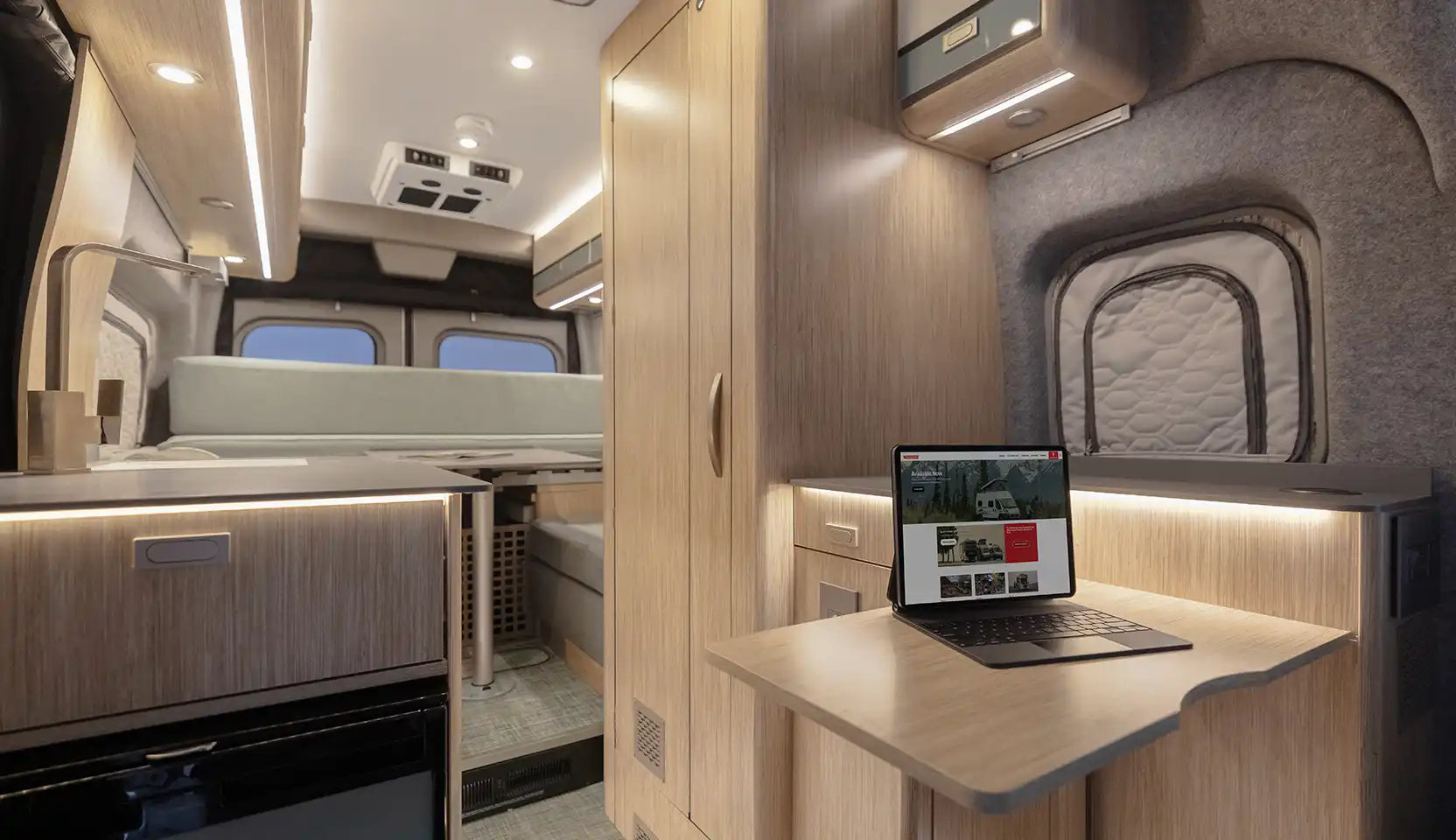
Interior of the Winnebago eRV2 Concept
The interior is calm and refined, according to ‘Japandi’ design principles, the weirdly popular term for a mix of Japanese and Scandinavian principles. It’s a far cry from the fussy country kitchen style (complete with artificial fireplace) that you’ll find in the company’s flagship $450,000-plus Journey. Watch this space for a production version.
Winnebago eRV2, concept only, Winnebago.com
Tonke EQV Nomad, Adventure and Touring
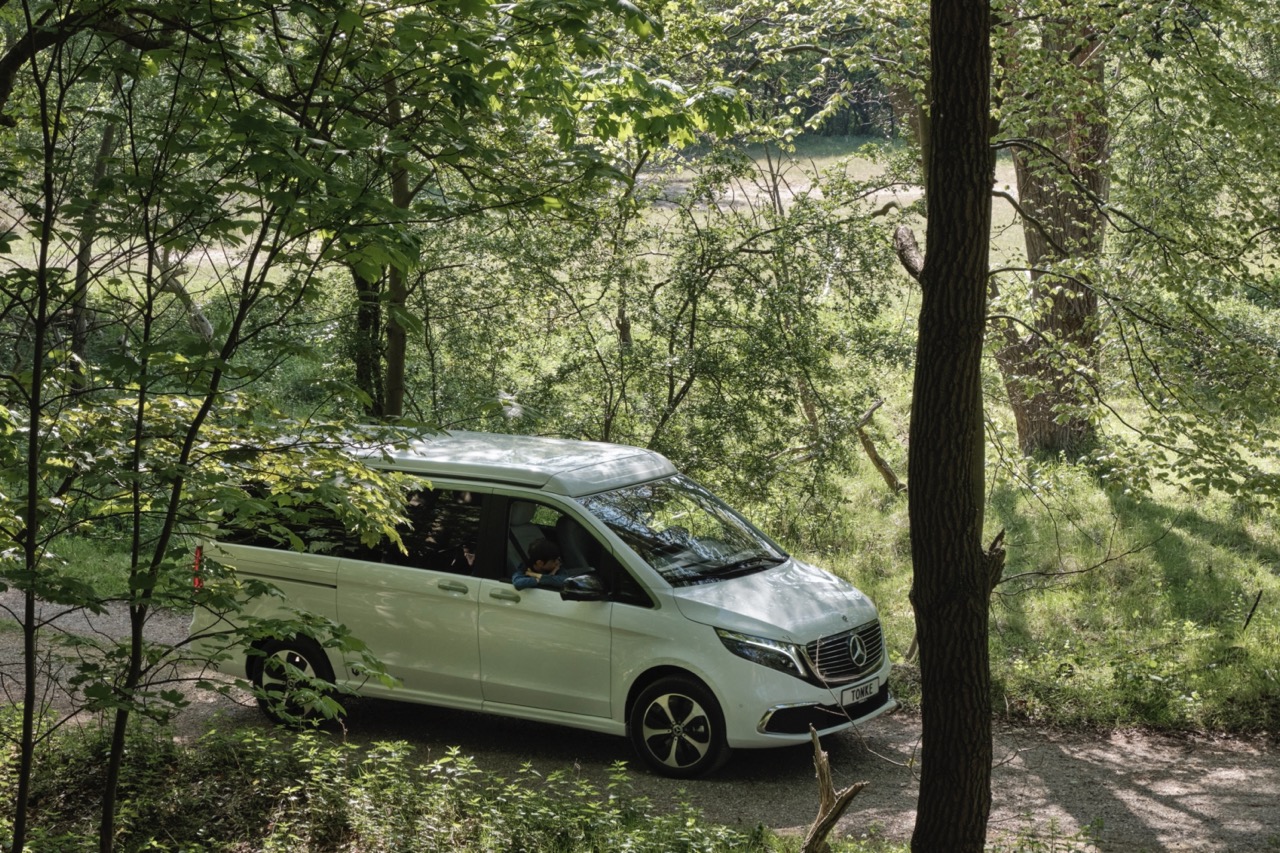
Tonke EQV
Tonke’s EQV conversions come in three variants, Adventure, Nomad and Touring. This minimal camper conversion of Mercedes’ EQV electric people carrier doesn’t compromise its passenger-carrying abilities. A folding double bed is created from the seats, along with a slide-out kitchen module, while an optional pop-up roof creates standing space, as well as the ability to add two more berths, depending on the chosen specification.
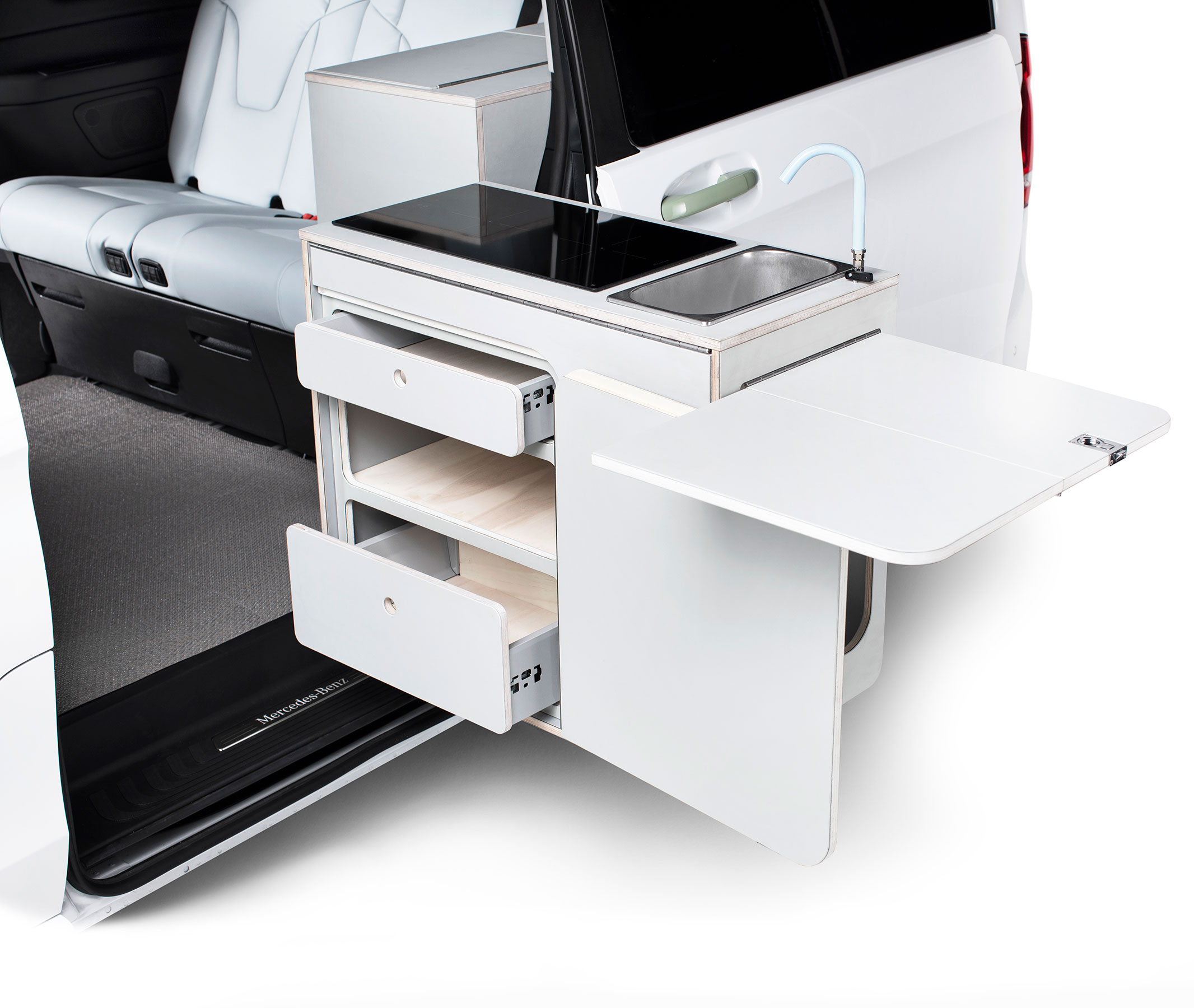
Slide out kitchen module in the Tonke EQV Touring
Space-saving measures are everywhere, including an optional drawer storage system that slides out of the rear tailgate. Maximum range for this converted Mercedes is said to be in line with the standard EQV, or around 224 miles.
Tonke EQV, from €73,919 ex VAT, MyTonkeEQV.com
Porsche Taycan with Porsche Roof Tent
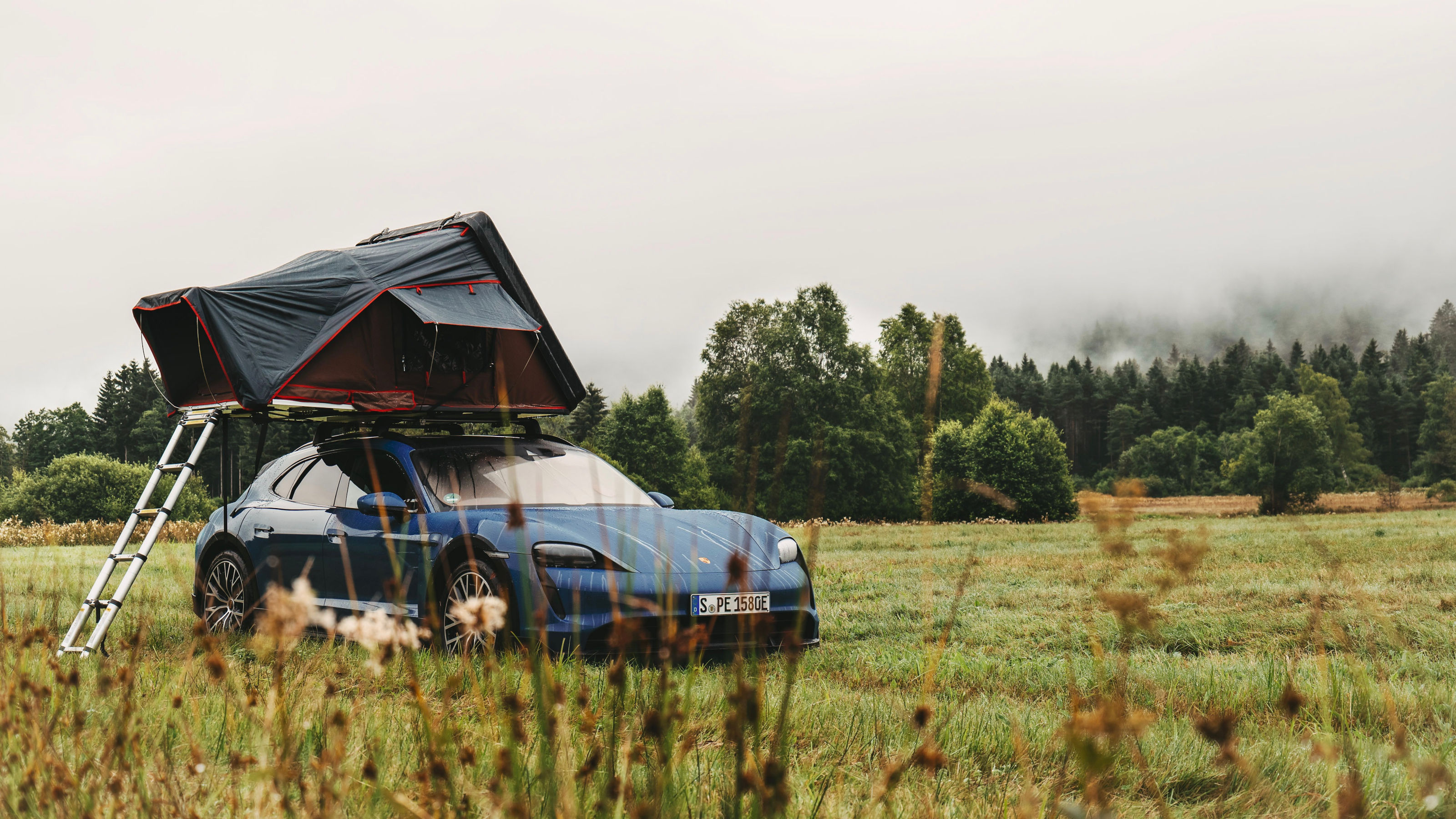
Porsche Taycan with Porsche Roof Tent
Porsche’s realisation that even sports-car drivers like the occasional spot of car camping saw it launch a dedicated roof tent for its models. Mounted up on the roof-rack and accessed via a ladder, the folding tent bears distinctive Porsche branding and folds down into a hard shell case that also contains the integrated access ladder.
Related article
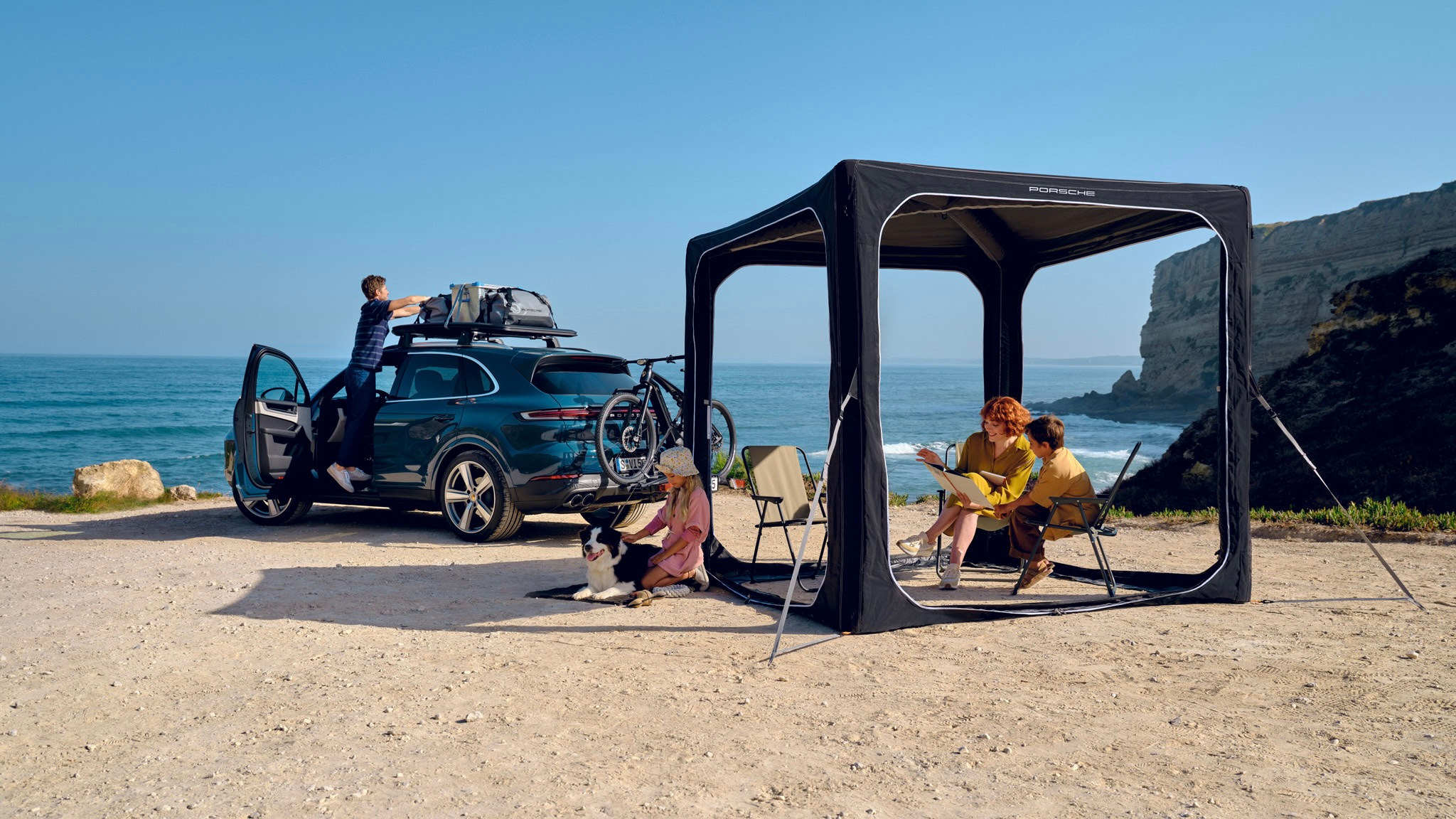
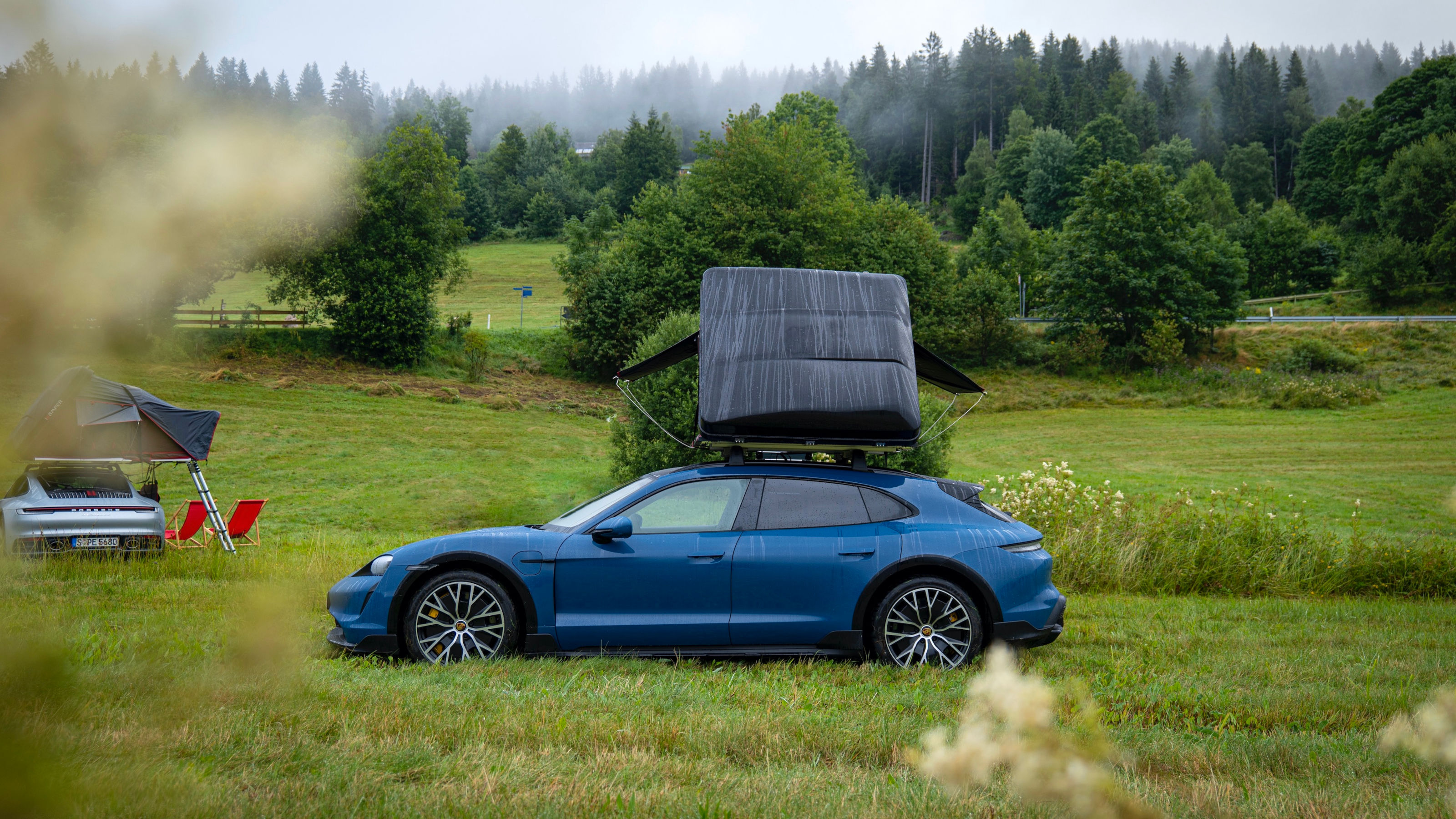
Porsche Taycan with Porsche Roof Tent
Inside there’s a polyfoam mattress, two side windows and a rooflight. For the ultimate – and fastest – zero emission way to camp, slot one of these on top of a Taycan, preferably the incredible Taycan Cross Turismo (which sadly has to be bought separately).
Porsche Roof Tent, available from Shop.Porsche.com
Mercedes Concept EQT Marco Polo

Mercedes Concept EQT Marco Polo
While others transform its new breed of EV vans into campers, so far Mercedes has only trailed the prospect of an electric version of its excellent Marco Polo camper. This model is a micro camper by most standards, with room for four at a push, but best thought of as a relatively luxurious space for two.
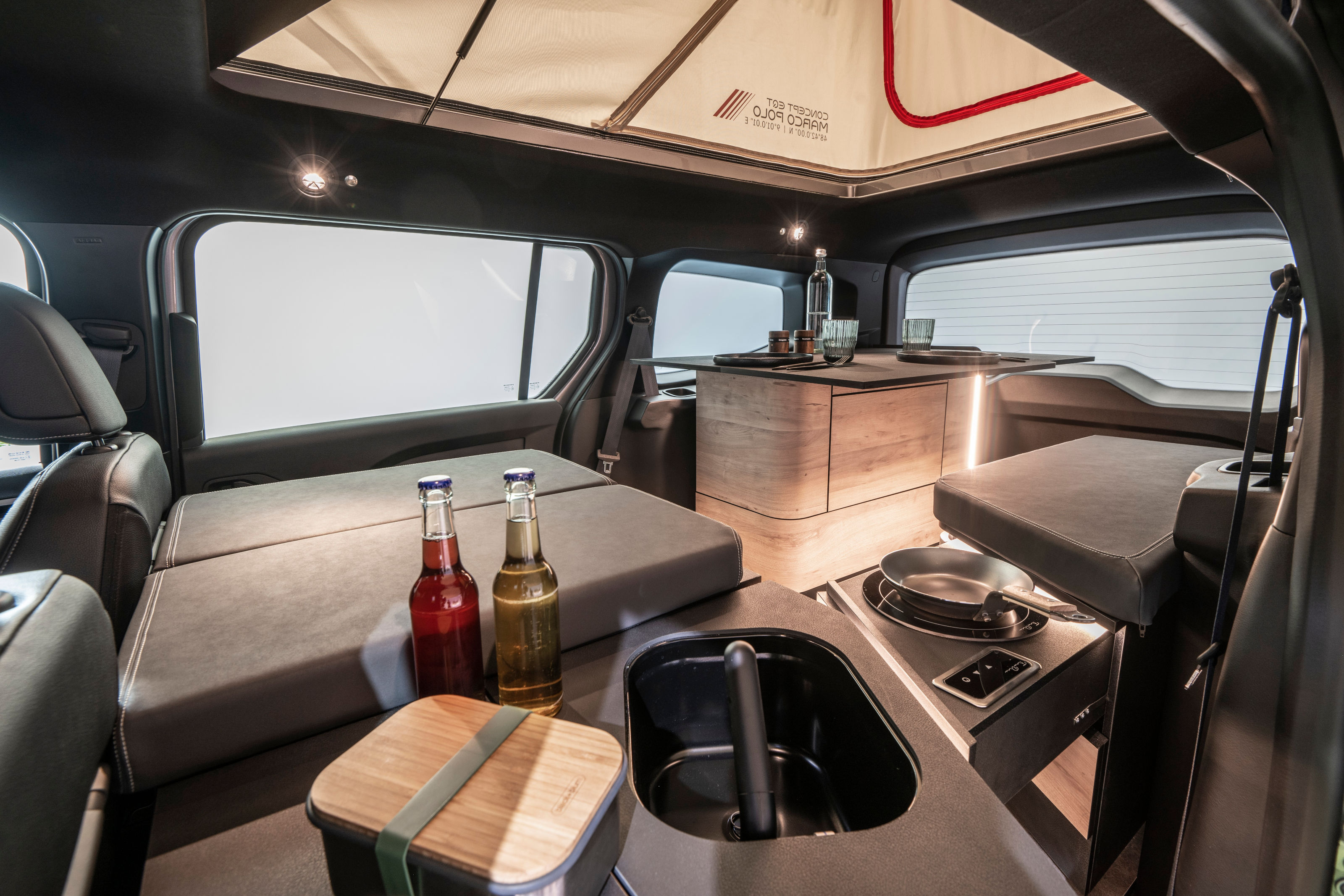
Interior of the Mercedes Concept EQT Marco Polo
The Concept EQT previews the forthcoming machine, with a fully removable interior – the Marco Polo Module – that transforms it from camper into van when required. Whether the production version will include this level of flexibility remains to be seen.
Mercedes Concept EQT Marco Polo, concept only, Mercedes-Benz.co.uk
Škoda Roadiaq Concept
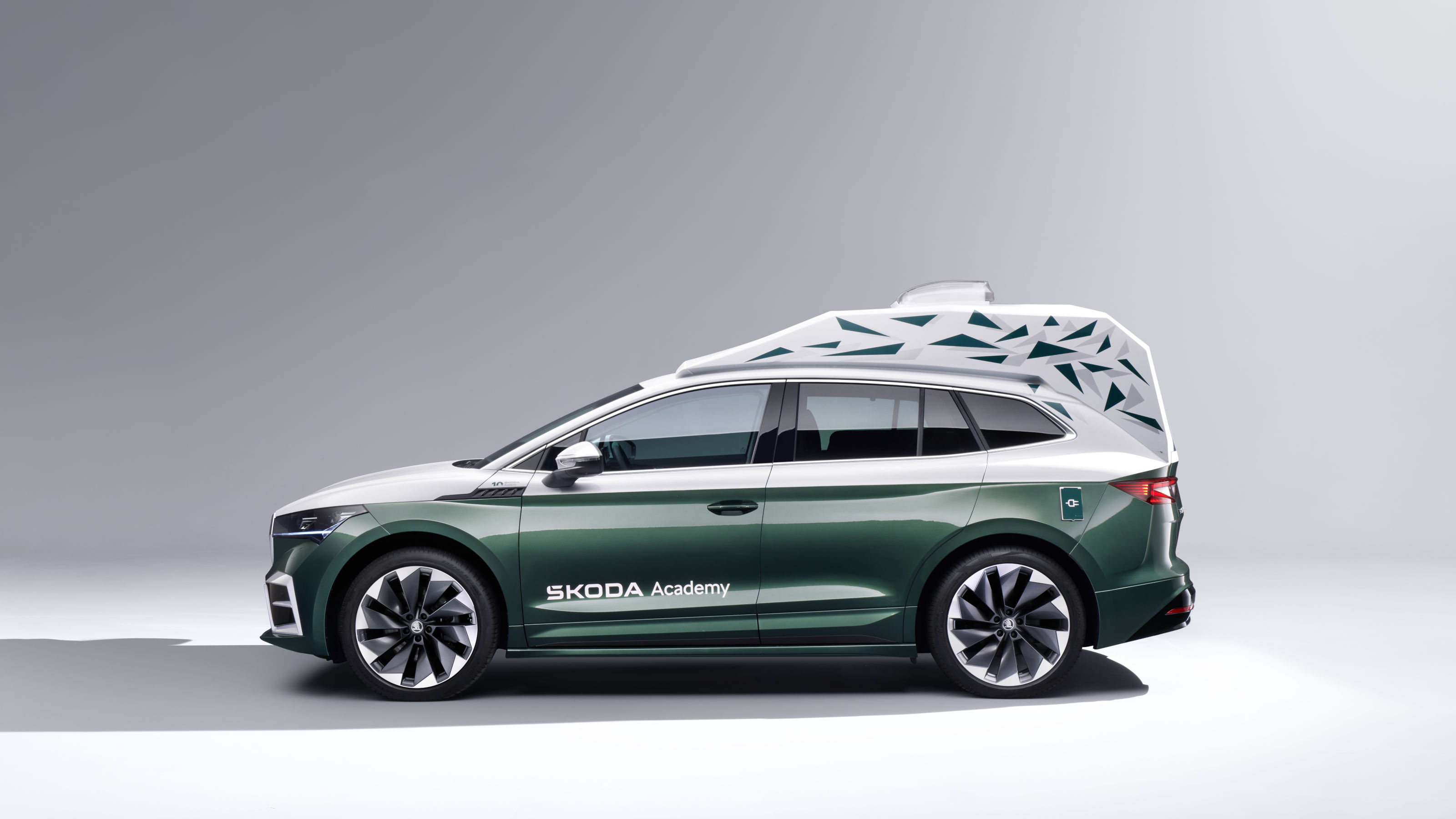
Škoda Roadiaq Concept
Škoda has already demonstrated its one-off Enyaq iV 80 FestEVal roof tent camper, but this student project takes that idea still further, adding an all-new roof structure and a finely crafted multifunctional interior that includes a kitchen and a full complement of leisure accessories.

Interior of the Škoda Roadiaq Concept
The Škoda Roadiaq is a fully functional concept made by 29 students from Škoda’s Vocational School. Solar cells help supplement the power supply for equipment like the built-in 27in monitor – aimed at those who want to live and work on the road.
Škoda Roadiaq, concept only, Skoda.co.uk
Jonathan Bell has written for Wallpaper* magazine since 1999, covering everything from architecture and transport design to books, tech and graphic design. He is now the magazine’s Transport and Technology Editor. Jonathan has written and edited 15 books, including Concept Car Design, 21st Century House, and The New Modern House. He is also the host of Wallpaper’s first podcast.
-
 The new Tudor Ranger watches master perfectly executed simplicity
The new Tudor Ranger watches master perfectly executed simplicityThe Tudor Ranger watches look back to the 1960s for a clean and legible design
-
 This late-night hangout brings back 1970s glam to LA’s Sunset Boulevard
This late-night hangout brings back 1970s glam to LA’s Sunset BoulevardGalerie On Sunset is primed for strong drinks, shared plates, live music, and long nights
-
 How Memphis developed from an informal gathering of restless creatives into one of design's most influential movements
How Memphis developed from an informal gathering of restless creatives into one of design's most influential movementsEverything you want to know about Memphis Design, from its history to its leading figures to the pieces to know (and buy)
-
 Rivian hits Miami Art Week to release R1S Quad Miami Edition, a new colour and a scent
Rivian hits Miami Art Week to release R1S Quad Miami Edition, a new colour and a scentVivid sights and evocative smells are part of Rivian’s quest to humanise its all-electric SUVs
-
 RBW EV brings a much-loved classic sports car aesthetic into the modern era
RBW EV brings a much-loved classic sports car aesthetic into the modern eraThe RBW Roadster and GT hark back to a golden age of sports car design. Under the skin, these British-built machines feature bespoke all-electric running gear
-
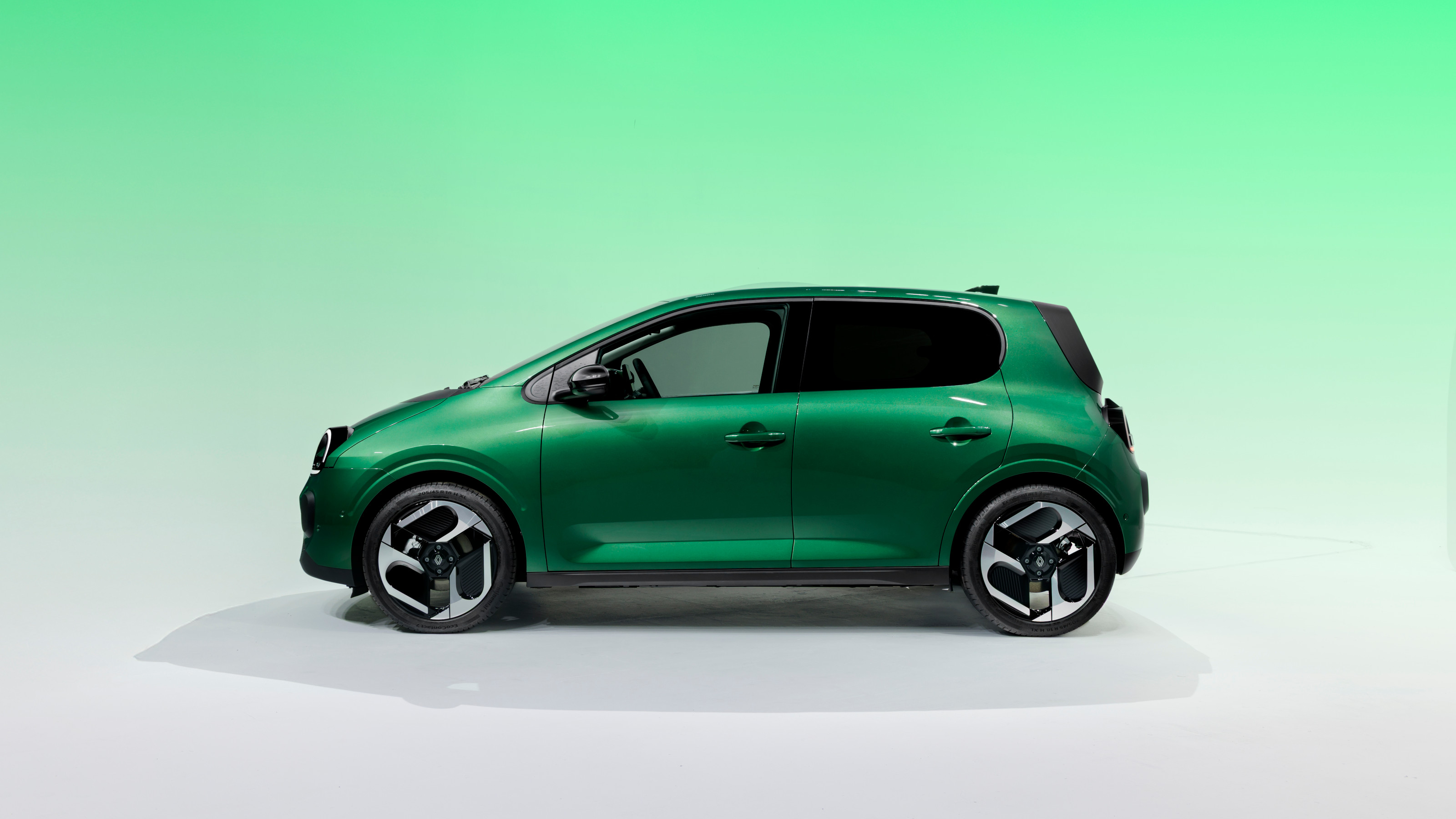 All hail the compact new Renault Twingo E-Tech – the city car is back in style
All hail the compact new Renault Twingo E-Tech – the city car is back in styleRenault continues to pay homage to its heritage by combining it with 21st-century technology. The new Twingo E-Tech is another winner
-
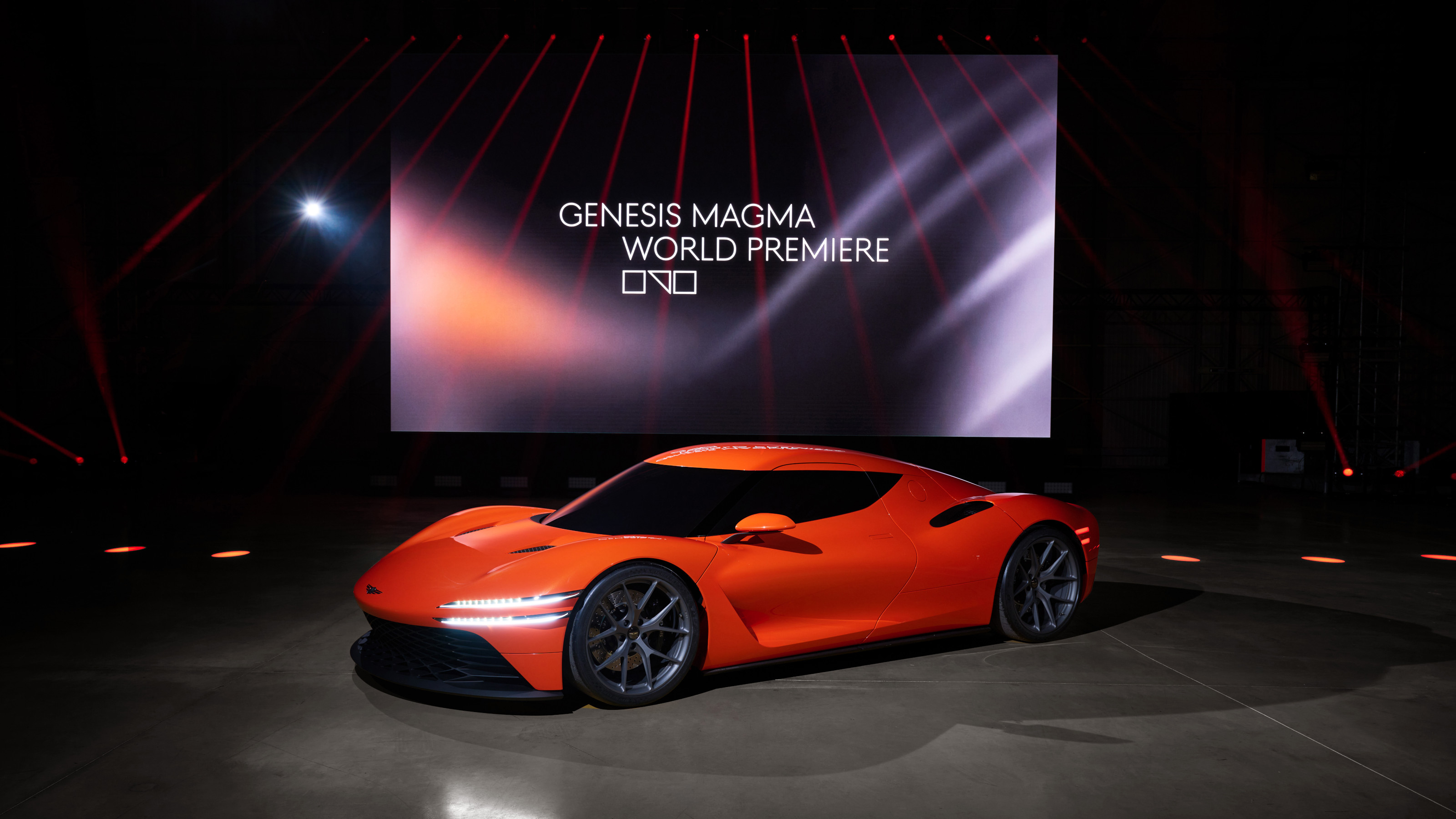 Genesis turns up the heat with its new Magma performance sub-brand
Genesis turns up the heat with its new Magma performance sub-brandGenesis has revealed the hot new GV60 Magma and striking Magma GT Concept in its quest to own luxury performance
-
 Around London in sybaritic silence with the majestic all-electric Lunaz Phantom V
Around London in sybaritic silence with the majestic all-electric Lunaz Phantom VClassic electrifier Lunaz has turned its skilled hands to the Rolls-Royce Phantom V. We sample the ultimate in zero-emission luxury on the streets of London
-
 Avatr Vision Xpectra concept transforms cars into ‘emotionally intelligent companions’
Avatr Vision Xpectra concept transforms cars into ‘emotionally intelligent companions’Revealed in Munich, electric car maker Avatr’s futuristic Vision Xpectra is a car that is not only beautiful, but a true form of ‘emotive luxury’
-
 Dacia wants to make small cars great again – all hail the new Hipster Concept
Dacia wants to make small cars great again – all hail the new Hipster ConceptThe best way to minimise energy use in all its forms is to downsize. The Dacia Hipster Concept is a smart way of making a practical car way more pint-sized
-
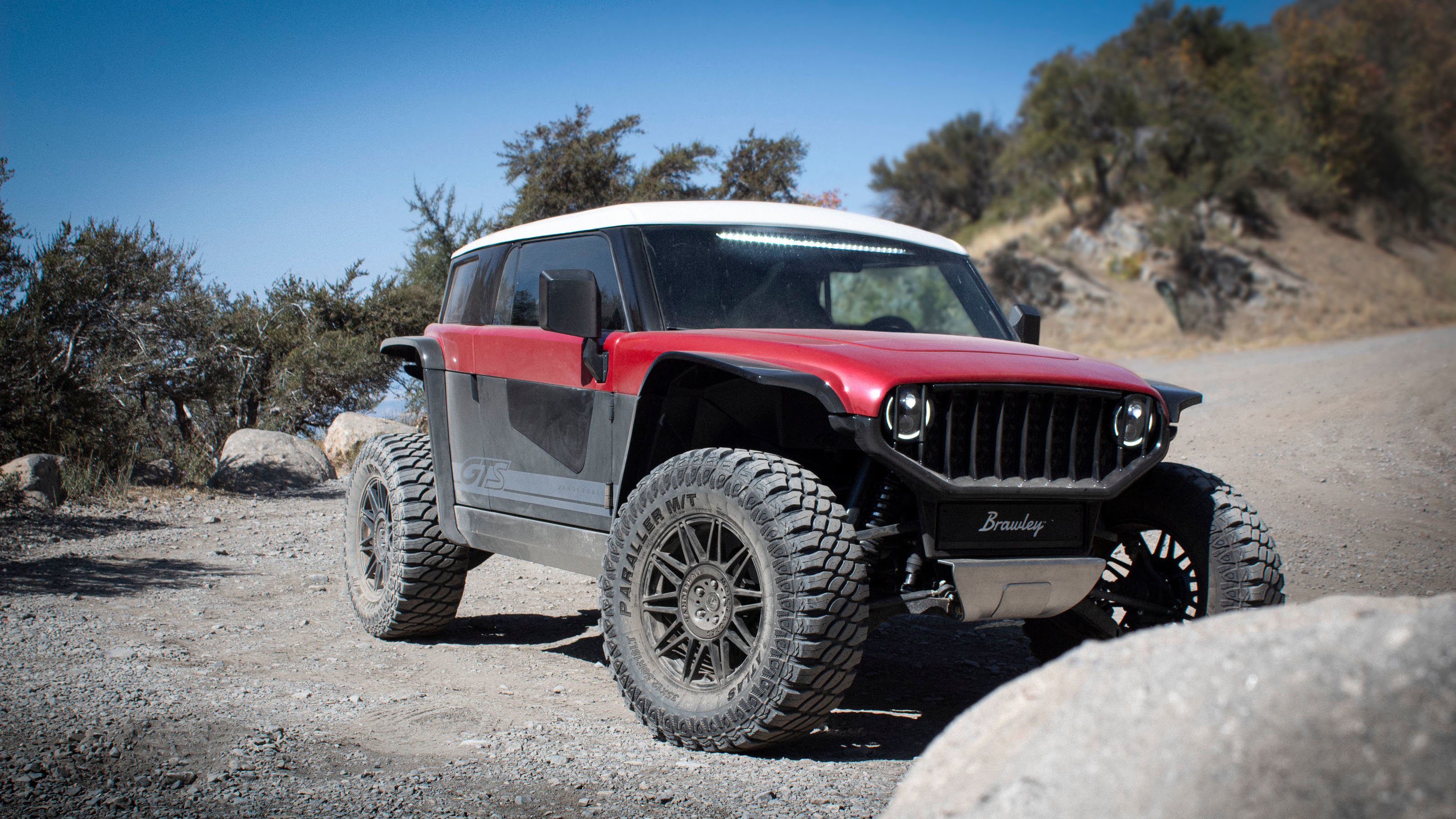 The Vanderhall Brawley GTS is a compact but mighty electric off-roader
The Vanderhall Brawley GTS is a compact but mighty electric off-roaderDeliveries of Vanderhall’s Brawley GTS have started, bringing zero-emission trail driving to enthusiasts across America